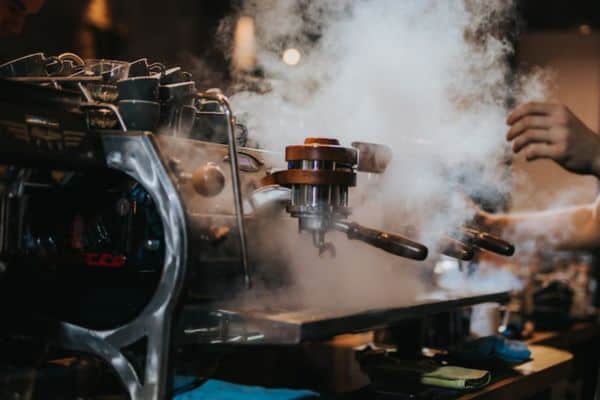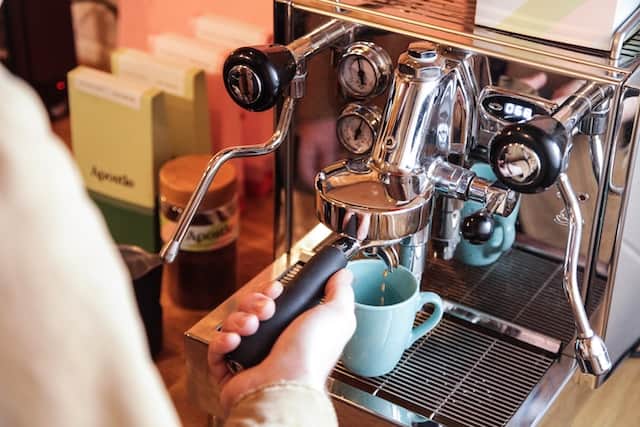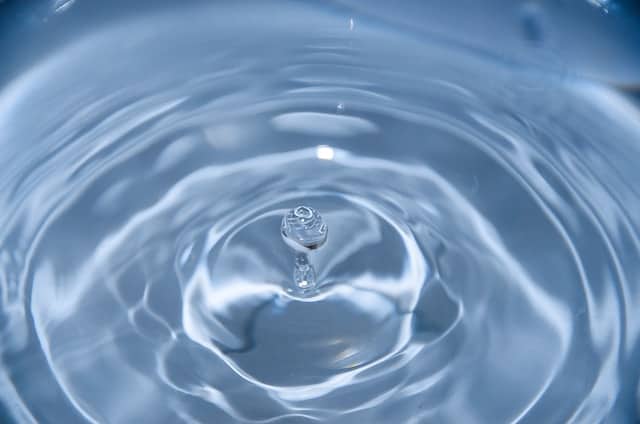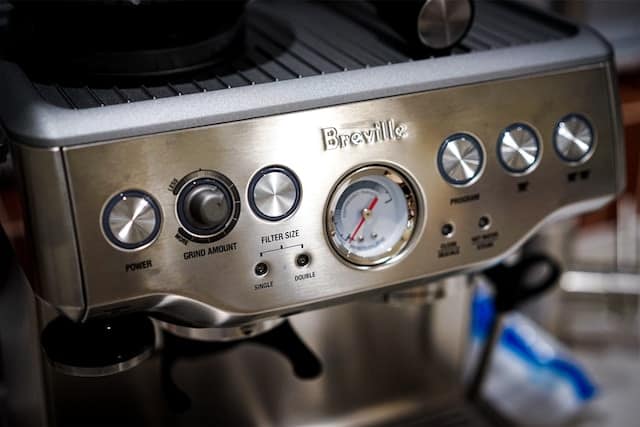Last updated on September 21st, 2023 by Jules Winnfield

Espresso is to you and I like water is to a seal: How do we live without it?!
But like any great love affair, the relationship between you and your espresso machine does require some maintenance.
And yes it may be a chore to do. But in order for your machine to consistently deliver your favorite creamy caffeinated beverage with great tasting quality, it needs tender loving care.
Enter the art of descaling.
Descaling your espresso machine is key to keeping it in tip-top shape and ensuring that every steaming cup of bliss is as delicious as the first.
In a nutshell, descaling involves removing the buildup of minerals and deposits that naturally collects in your espresso machine from the water. Armed with some simple know-how and a few household items, like vinegar, you’ll learn how to descale an espresso machine and have your trusted partner in caffeine consumption running at peak performance in no time.
- Why descale your machine?
- Descaling Solutions and Ingredients
- Preparing Your Espresso Machine for Descaling
- How to Descale an Espresso Machine: Step by Step
- Maintaining Your Machine Between Descaling Sessions
- Tips for Extended Machine Life and Better Tasting Coffee
- How to Descale Specific Espresso Machine Brands
- FAQs
Why descale your machine?

Photo by Jon Stanford
Just like Iron Man swoops down and takes out all the bad guys with his elite guidance targeting system in one fell swoop, descaling is the targeting tool that helps keep your espresso machine running smoothly.
Why is it so important?
First of all, let me introduce you to the villain of this story: hard water.
Hard water is sneaky. It contains minerals that, while harmless to your health, have a sneaky desire to set up shop in your espresso machine through mineral buildup. This mineral fortress, also known as limescale, is a problem for several reasons:
- It can damage internal parts over time.
- Limescale deposits can alter performance. For example, the water temperature may not get as hot as you like. This in turn can affect extractions and lead to a cup that isn’t as good as you’re used to.
- Limescale can host unwelcome guests like bacteria which compromise the taste of your coffee and even cause damage to the machine parts
Now, you might think, “I’m smarter than hard water. I only use bottled water!” And while that sounds like a brilliant plan, even bottled water can contribute to limescale buildup over time.
Hence descaling your machine is a worthy ally! Not only does it get rid of bacteria hosting limescale, but the internal parts are kept in tip top shape, which prolongs the life of your machine.
Ultimately, this means better coffee taste and aroma. All the better to slay the day with!
Descaling Solutions and Ingredients

Photo by David Becker
To go into battle you need the right tools. So here are a few options to consider in your arsenal in your descaling fight.
Commercial Descaling Solutions
These bad boys are specifically designed to get the job done and make your espresso machine look brand new again. Various brands and manufacturers will have their own; worth considering especially if your machine is a pricey one and you don’t want to risk using anything else.
Vinegar
The classic household staple. Your trusty white vinegar is not only great for dressing a salad, but it’s also an efficient descaler.
A nice ratio to consider is mixing 3 parts of water to 1 part white vinegar. You can even go up to a 50-50 ratio.
Citric Acid
For a more natural route, consider sour salt (a.k.a. citric acid); it’s most commonly found in powder or dry powder form.
Two tablespoons of citric acid mixed with one quart of water will create a zesty solution that is perfect for tackling stubborn mineral deposits.
Lemon Juice
Combining the powers of Vitamin C and zestiness, lemon juice is another effective alternative. Mix equal parts water and lemon juice to create a tangy and effective descaling solution.
Preparing Your Espresso Machine for Descaling

Photo by Jennifer Bedoya
Before we can get started, we need to prepare your precious caffeine dispenser for the process. Here’s what you need to do:
Empty the water tank
To avoid a mess, unplug your espresso machine, take out the water tank, and empty it. You’ll thank me later.
Remove the portafilter and basket
Give them a gentle tug to remove them from the group head. While you’re at it, why not give them a good rinse?
Dismantle the steam wand
Unscrew the tip and remove the rubber gasket. Make sure to store these small parts somewhere safe—we wouldn’t want them accidentally disappearing!
Clean the drip tray
Give your drip tray the royal treatment by taking it out and giving it a thorough clean.
And just like that, your espresso machine is stripped down and ready for its descaling treatment! Don’t worry, we’ll put everything back together again when we’re done.
How to Descale an Espresso Machine: Step by Step

Photo by Alesia Kazantceva
Fill the Tank with Descaling Solution
First, you’ll need to mix up a batch of descaling solution. This can be a commercial cleaner or any of the options we mentioned above. Fill your water tank with the mixture you just prepared.
Initiate the Descaling Cycle
Refer to your machines manual (or any video online) to find how to activate the descaling mode. This could be as easy as pressing a button or as complex as flipping certain switches. Once you figure it out, let the descaling process work its magic.
Rinse All Components Thoroughly
Once the cycle completes, empty the water tank, give it a thorough cleaning, and fill it back up with clean water.
Run a couple of brewing cycles to flush out any lingering traces of the descaling solution, ensuring that your next espresso isn’t… well, vinegary.
Don’t forget to rinse all the components that you removed earlier too.
Reassemble the Machine
Once everything is squeaky clean and rinsed to perfection, it’s time to put your precious machine back together. Assemble all the components in their rightful places, making sure everything clicks, fits, and feels just right.
Voilà! Your espresso machine now looks and feels so fresh and so clean!
Maintaining Your Machine Between Descaling Sessions

Photo by Kevin Schmid
Regularly Clean the Exterior
In between uses, you can always make a little time to do the little things to keep your baby looking nice and polished. For example, wipe it down every couple of days with a damp cloth to remove coffee residues, smudges, and other mischief-makers.
Purge the Steam Wand After Use
To avoid any buildup of milk and calcium, purge your steam wand after each use. Simply open the steam valve and release steam for a few seconds until it spits out any lingering milk particles. Give it a quick wipe with a damp cloth, and your steam wand will blow hot and fresh for that next cappuccino.
Backflush the Group Head
Backflushing is like a mini spa treatment for your coffee maker. Remove the portafilter, insert a blind basket, and run water through it. This helps dislodge any stubborn coffee grounds and oils hiding in the nooks and crannies.
Perform a backflush every day or two if you’re using a commercial machine, and about once a week for home use machines.
Tips for Extended Machine Life and Better Tasting Coffee

Photo by Kevin Butz
If you want your espresso machine performing at a high clip for a long time, then here’s a few tips and tricks to consider. You will also get better tasting espresso as a bonus!
Use Filtered or Soft Water
Not only does switching to filtered water improve the taste of your espresso, it also reduces limescale build-up inside your machine. This means less descaling, less maintenance, and more time to enjoy your caffeine fix.
Don’t overpack the Coffee Grounds
Overpacking coffee grounds into the brew basket won’t get you stronger coffee. All it does is create excess pressure and clog your machine, leaving you with a mess to clean and a disappointing cup of coffee.
Best to stick with recommended coffee grounds and water ratios.
Invest in Specialty Coffee Beans
Specialty coffee beans from reputable roasters not only up the flavor and your overall coffee drinking experience but are also great for your machine. High-quality beans leave fewer residues and oils, leading to less frequent cleaning and a happier espresso maker.
How to Descale Specific Espresso Machine Brands

Photo by ün LIU
Because these brands are so commonly used, here’s a quick guide on how to descale these machines. Remember to refer to their specific manuals for more detailed instructions if you need it.
Breville
- First, mix your descaling solution – a mixture of water and white vinegar or a descaling tablet.
- Next, pour the solution in the water tank and run a brewing cycle.
- Finally, perform a couple of additional cycles with plain water to rinse everything out.
For a more detailed guide, check out Breville’s tutorial on descaling.
Keurig
Keurig doesn’t have too many espresso machines in their lineup, but we’re adding it since it’s a popular single serve option. To descale:
- Simply fill your reservoir with a 1-to-1 mixture of white vinegar and water.
- Brew until the reservoir is almost empty, and then let your machine sit for 30 minutes.
- Finally, rinse your Keurig by running water-only cycles until the vinegar smell is gone. It may take a few cycles.
Nespresso
Nespresso machines will generally let you know when descaling is needed via lights and alerts. But no reason to wait till then to get it clean.
- First, empty and rinse the water tank then refill it with a descaling solution.
- Activate the descaling mode by holding down specific buttons for a few seconds (check your user manual for the exact button combo).
- Start the descaling cycle. Nespresso machines will run two back-to-back cycles, expelling the solution.
- Once it’s done, turn off descaling mode and give your machine a good water-only rinsing cycle or two.
De’Longhi
A well-known Italian espresso machine brand, descaling looks like this:
- Begin by filling the tank with water and descaler.
- Turn the machine on, wait for it to heat up, and then run the descaling cycle.
- After the cycle is complete, refill with fresh water and run a water-only cycle.
FAQs
Is descaler better than vinegar?
While vinegar is cheap, readily available, and may be great for decalcifying mineral deposits, it’s not the ideal option for your espresso machine. Manufacturers will often recommend their own descaling solutions because they are specifically formulated to break down deposits while being less harsh to your machine.
How often should I descale my espresso machine?
Your espresso machine deserves regular attention! Most manufacturers suggest descaling every 2-3 months depending on the water hardness and how often you use your machine. However, consult your machine’s manual for specific recommendations.
Can I use citric acid to descale my espresso machine?
Citric acid may seem like a posh alternative, but tread carefully! Some manufacturers may caution against using it as it can harm your machine’s delicate components.
Coffee Has Never Read This Good!
Sign up for a FREE newsletter to the best home brewing tips and guides
Thank you for subscribing to The Cup Coffee House Crew! There's a surprise in your Inbox 🙂
Something went wrong.
- About the Author
- Latest Posts

“Jules” is a pharmacist by day and investor, writer, and health nut by night. When he’s not sipping on some coffee laced with MCT oil during an 18 hour fast, he is writing about how to get your coffee grind on or playing Monopoly with his 2 boys and wife. Ahh…life is good!
